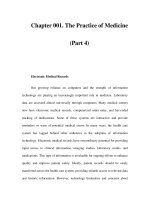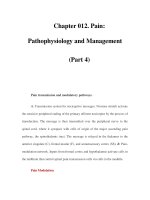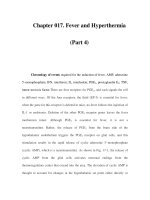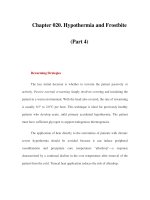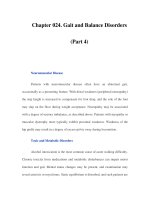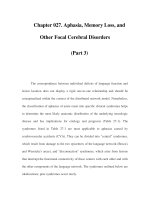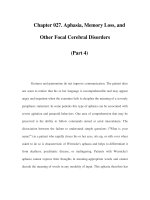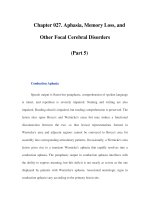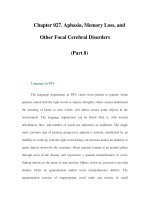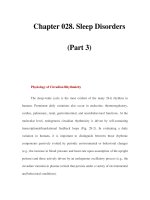Chapter 076. Eating Disorders (Part 4) pot
Bạn đang xem bản rút gọn của tài liệu. Xem và tải ngay bản đầy đủ của tài liệu tại đây (43.14 KB, 5 trang )
Chapter 076. Eating Disorders
(Part 4)
Table 76-2 Diagnostic Features of Anorexia Nervosa
Refusal to maintain body weight at or above a minimally
normal weight for age and height. (This includes a failure to achieve
weight gain expected during a period
of growth leading to an
abnormally low body weight.)
Intense fear of weight gain or becoming fat.
Distortion of body image (e.g., feeling fat despite an
objectively low weight or minimizing the seriousness of low weight).
Amenorrhea. (This criterion is met
if menstrual periods occur
only following hormone—e.g., estrogen—administration.)
The diagnosis of AN can usually be made confidently in a patient with a
history of weight loss accomplished by restrictive dieting and excessive exercise,
accompanied by a marked reluctance to gain weight. Patients with AN often deny
that they have a serious problem and may be brought to medical attention by
concerned family or friends. In atypical presentations, other causes of significant
weight loss in previously healthy young people should be considered, including
inflammatory bowel disease, gastric outlet obstruction, diabetes mellitus, central
nervous system (CNS) tumors, or neoplasm (Chap. 41).
Prognosis
The course and outcome of AN are highly variable. One-quarter to one-half
of patients eventually recover fully, with few psychological or physical sequelae.
However, many patients have persistent difficulties with weight maintenance,
depression, and eating disturbances, including BN. The development of obesity
following AN is rare. The long-term mortality of AN is among the highest
associated with any psychiatric disorder. Approximately 5% of patients die per
decade of follow-up, primarily due to the physical effects of chronic starvation or
by suicide.
Virtually all of the physiologic abnormalities associated with AN are
observed in other forms of starvation and markedly improve or disappear with
weight gain. A worrisome exception is the reduction in bone mass, which may not
recover fully, particularly when AN occurs during adolescence when peak bone
mass is normally achieved.
Anorexia Nervosa: Treatment
Because of the profound physiologic and psychological effects of
starvation, there is a broad consensus that weight restoration to at least 90% of
predicted weight is the primary goal in the treatment of AN. Unfortunately,
because most patients resist this goal, the management of AN is often
accompanied by frustration for the patient, the family, and the physician. Patients
typically exaggerate their food intake and minimize their symptoms. Some
patients resort to subterfuge to make their weights appear higher, for example, by
water-loading before they are weighed. In attempting to engage the patient in
treatment, it may be useful for the physician to elicit the patient's physical
concerns (e.g., about osteoporosis, weakness, or fertility) and, provide education
about the importance of normalizing nutritional status in order to address those
concerns. The physician should reassure the patient that weight gain will not be
permitted to get "out of control" but simultaneously emphasize that weight
restoration is medically and psychologically imperative.
The intensity of the initial treatment, including the need for hospitalization,
is determined by the patient's current weight, the rapidity of recent weight loss,
and the severity of medical and psychological complications (Fig. 76-1).
Hospitalization should be strongly considered for patients weighing <75% of
expected, even if the results of routine blood studies are within normal limits.
Acute medical problems, such as severe electrolyte imbalances, should be
identified and addressed. Nutritional restoration can almost always be successfully
accomplished by oral feeding, and parenteral methods are rarely required. For
severely underweight patients, sufficient calories (approximately 1200–1800
kcal/d) should be provided initially in divided meals as food or liquid supplements
to maintain weight and to permit stabilization of fluid and electrolyte balance.
Calories can then be gradually increased to achieve a weight gain of 1–2 kg (2–4
lb) per week, typically requiring an intake of 3000–4000 kcal/d. Meals must be
supervised, ideally by personnel who are firm regarding the necessity of food
consumption, empathic regarding the challenges entailed, and reassuring about the
patient's eventual recovery. Patients have great psychological difficulty complying
with the need for increased caloric consumption, and the assistance of psychiatrists
or psychologists experienced in the treatment of AN is usually necessary.
Figure 76-1
